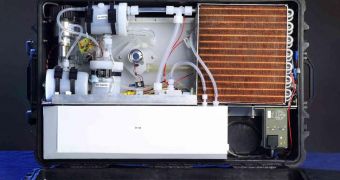SFC Energy, Inc., the US affiliate of SFC Energy AG, has just been awarded a non-exclusive license to develop a new type of technology, which was put together by experts at the NASA Jet Propulsion Laboratory (JPL) and the University of Southern California in Los Angeles (USC).
The new technology is called Direct Methanol Fuel Cell (DMFC), and it was initially put together for commercial applications and the US Department of Defense. Now moved into the private sector, the technology is expected to yield even more uses.
The main expectation experts have of DMFC is to bring fuel cell technology to the market, and make these devices more efficient and affordable. The approach was licensed by the California Institute of Technology (Caltech), in Pasadena, and USC.
Caltech manages the JPL for NASA, and as such has control over how technologies developed here are licensed and developed further. Rather than hydrogen, DMFC uses liquid methanol as the main fuel source for producing electrical energy.
The advantage to doing so is that this doesn't require any sort of fuel processing. While conducting its chemical reactions, the new fuel cell produces no pollutants. Its only byproducts are water and carbon dioxide, experts say.
Two of the most important advantages that the new technology has over its competitors are simplicity of design and higher energy density. Transporting and storing hydrogen gas is a lot more complex than doing the same thing for methanol.
“JPL invented the Direct Methanol Fuel Cell concept and also made significant contributions to all the facets of the technology,” explains Rao Surampudi, who is the manager of the JPL Power Technology Program.
“These contributions include: development of advanced catalyst materials, high-performance fuel cell membrane electrode assemblies, compact fuel cell stacks, and system designs,” he goes on to say.
“We are looking forward to working closely with the fuel cell industry to further develop this technology to meet future market needs,” adds expert Erik Brandon, who holds an appointment as the current Electrochemical Technologies group supervisor at the JPL.
According to a press release from the Lab, the new technology could be used to create advanced battery chargers for consumer electronics, electric vehicles, stand-alone power systems, and uninterrupted/emergency power supplies, among many others.

 14 DAY TRIAL //
14 DAY TRIAL //